Taming the ‘West’
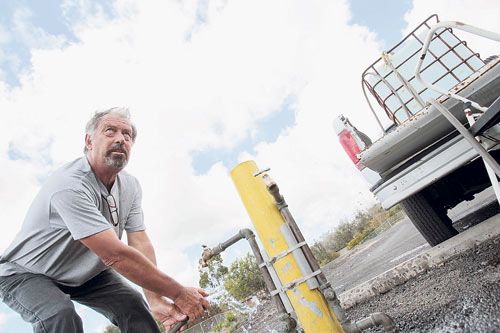
Ocean View resident Gary Schauweker loads up on potable water from a spigot at the community well, a $6 million addition to the subdivision as it adapts to its growing population.

Steven Soren constructed the 6-foot-by-8-foot shed on his acre of land that he calls home. He moved here six months ago.
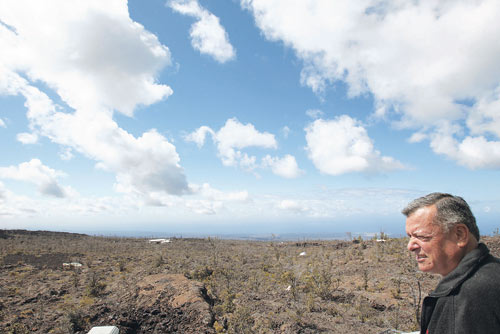
Jack Marx, who moved to Ocean View in 1995, lives off the grid in a seven-bedroom house he built himself. One of the perks of his home, he says, is his expansive view of the Kau coastline.

Genny Galletes was at the market with a granddaughter, selling items as a fundraiser for a summer program for kids. All of her children were raised in Ocean View and have stayed in the community.
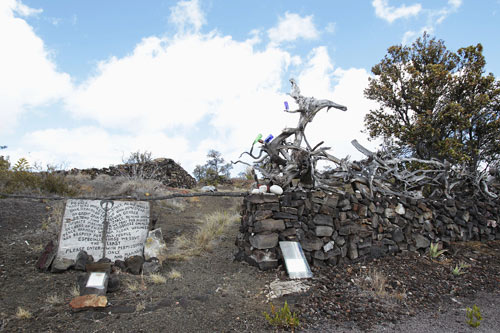
Some Ocean View properties are in disarray, but their owners say they prefer being able to live a rustic, unmonitored lifestyle.
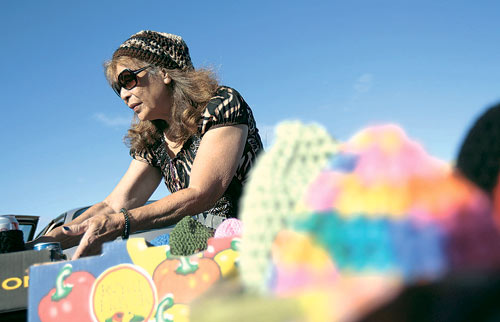
Helene Hart, who moved to Ocean View seven years ago, sells beanies she knits herself.
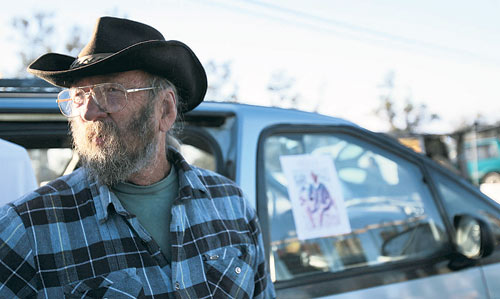
Dennis Smith runs the Ocean View farmers market.
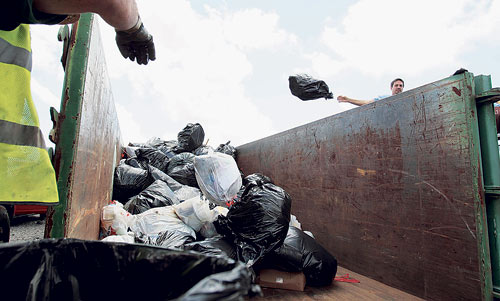
Trash is collected weekly at a community transfer station. Residents can wait in line for up to an hour in order to dispose of their garbage.
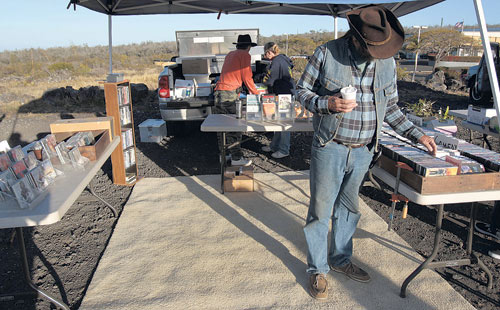
Dennis Smith browses a display at the Ocean View farmers market. “The thing that attracts everybody in the beginning is it’s cheap,” Smith says of the area. “But we have a good community, it’s like a family.”
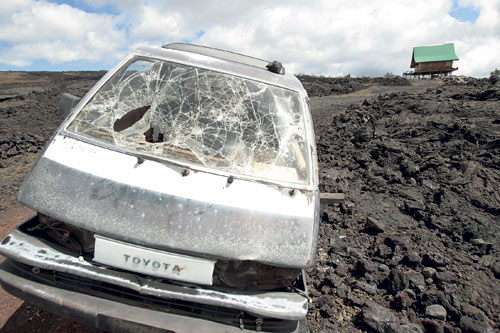
The parcels of land in Ocean View are appealing for their cheap prices, and they attract a wide variety of owners. Some people choose to leave their lots minimally occupied, with little more than vans or temporary structures.










HAWAIIAN OCEAN VIEW ESTATES >> This outpost on the slopes of Mauna Loa has long had a reputation as the "wild, wild west," a haven for drugs, for anything goes, and for people who wanted little to do with the outside world.
But the nation’s largest subdivision in terms of size — with 11,000 1-acre lots — has gone through a decided transformation over the last two decades.
Today, about 6,000 people live in all of Ocean View, most in the subdivision dubbed "HOVE" (rhymes with cove). That’s up from less than 1,000 in 1990.
In the last decade especially, many islanders and mainlanders have migrated here because of the affordability of land — an acre can go for as little as $5,000 to $10,000, depending on where it is in the subdivision.
And with the flood of new people, a new sense of community has come to HOVE. There is a neighborhood watch and a strong resident association. There are weekend craft fairs and farmers markets. The community center offers a preschool and square-dancing classes.
Don't miss out on what's happening!
Stay in touch with breaking news, as it happens, conveniently in your email inbox. It's FREE!
With the subdivision’s growth has come new conveniences, too. Last year, the county opened a $6 million well in HOVE, where people can pump potable water. One day a week, trash is accepted at a community transfer station.
Christine Gallagher, a real estate agent who has lived in the subdivision for 34 years, said Ocean View still has its quirks. It’s just a lot friendlier these days.
On a recent Saturday, Gallagher, a petite woman with short-cropped hair, was selling knives, sunglasses and brass knuckles at Ocean View’s farmers market, where lots of residents come to get a bargain or to offer one.
She said HOVE — and, by extension, Ocean View — has "developed into a different community."
"We get all kinds, and it’s not for everyone," she said, adding that many people, especially mainlanders, move in only to leave within the year because of the rugged lifestyle — or the neighbors. "People who don’t fit in anywhere else fit in here."
THEFT AND DRUGS are still problems, too, as is the preponderance of "alternative" — often unpermitted — structures. HOVE’s association estimates that at least half of homes built in the subdivision don’t have permits; a fair number of residents live in tents, shipping containers, shacks or yurts. One woman even lives in a lava tube.
But 20 years ago, no one imagined that HOVE would be having spaghetti-dinner fundraisers to help pay for kids’ programs or that residents would be gathering on weekends to buy produce and household goods from one another — and do some neighborly catching-up.
"The thing that attracts everybody in the beginning is it’s cheap," said Dennis Smith, 70, who runs the Ocean View farmers market. "But we have a good community, it’s like a family."
At the market, Smith stood near a table with pamphlets about the Kau district, and about Ocean View. He acknowledged there are still some bad elements in the community, and there are still people who want to be left alone.
"We still have our share of problems, and we’re weeding them out as fast as we can," he said. "We’re kind of grown up. We’ve had to fight our way through the thieves."
The changes seen in Ocean View are part of the bigger story of population growth on Hawaii island. Increasingly, people looking for a land bargain are snapping up unimproved parcels in subdivisions created in rural areas decades ago.
The fastest-growing area of Hawaii island is the expansive Puna district, where — despite a lack of infrastructure in subdivisions — the population has more than doubled since 1990 and is forecast to top Hilo’s before the end of the decade.
The growth in Ocean View is often compared to what has been seen in Puna, only on a smaller scale.
Just like in Puna, the influx of people in Ocean View is changing a community and a landscape, creating the need for improved infrastructure and services, and raising questions about how much growth is too much.
County Councilwoman Brenda Ford, whose district includes the area, said the difference is that Ocean View was synonymous among Hawaii islanders with drugs and crime.
"It’s calmed down quite a bit," she said. "It’s no longer the wild, wild west."
BUT WITH THE NEWCOMERS, many of them families, have come new problems, too.
Work is hard to find nearby, so people often must commute long distances to work. Getting children to school can also be a feat — the nearest elementary school is 30 minutes away in Naalehu, and the nearest high school is in Pahala, a 45-minute drive.
And there is the issue of services, Ford said. For example, two police officers patrol Kau, the island’s largest district in terms of size. So calling the police usually means a fairly long wait.
Accessing most county services, meanwhile, requires driving two hours to Kona or Hilo. That’s a particularly onerous burden on many who live in Ocean View, where the median income of a family in 2011 was $45,000, compared to $65,000 for Hawaii County, according to U.S. Census figures.
Parcels in HOVE and several other Ocean View subdivisions, including Hawaiian Ranchos and Kona Garden Estates, started going on the market in the 1950s.
In Ocean View, as in Puna, large developers got permission to subdivide huge parcels of undeveloped land, selling the individual unimproved lots to people from around the world.
Today, about 1,300 lots in HOVE are officially occupied, which doesn’t count parcels where people are living in vans, tents or other temporary structures.
The subdivision, mauka of the highway, begins at about 2,000 feet above sea level, where ohia forests provide a natural canopy. The highest lots in the subdivision are at about 5,000 feet above sea level. Progressing up the subdivision, the trees give way to barren lava-rock lots — a stark reminder that HOVE is on Mauna Loa’s southwest rift zone, a "lava zone 2." (A zone 1 area has the greatest hazard).
At the upper elevations, a virtual moonscape, the air is chilly — most days, temperatures are in the 60s, though they can dip below freezing at night during the winter.
Jack Marx, 66, lives near the top of the subdivision, in a seven-bedroom house he built himself. It’s a quaint A-frame, painted celadon and lime, that sticks out conspicuously in the treeless landscape.
Marx moved to Ocean View in 1995, and, like most residents in the subdivision, he lives off the grid: He uses solar power for most of his energy needs, has generators for backup, and catches his own drinking water or has it trucked in.
He said HOVE has a different pace, and offers a different lifestyle.
"It’s tougher to live out here," he added. "There are rough people."
When asked why he stays, he went to his lanai, where he pointed to his view of 24 miles of Kau coastline.
He added, with a laugh, "I’m just not crazy about living around too many people."
Genny Galletes, 52, moved to Ocean View 20 years ago with her husband and four of her children.
"It was very sparse, very wild," she said, laughing.
Her four children — and three more who came along — were raised in Ocean View and all of them have stayed.
GALLETES WENT to the farmers market on a recent Saturday morning with one of her granddaughters. The two were selling framed photos of Hawaii scenes and foliage as a fundraiser for a summer program for kids.
Galletes, her curly hair brushed back from her face, said when she moved into Ocean View, the roads weren’t paved (as they are now) and there were no street signs.
"It takes a certain kind of person to live here," she said.
Galletes added she’s well aware of Ocean View’s tough reputation, but has never encountered any problems. "You respect each other, you get respected back," she said. "Everyone knows to be aware, that’s all."
She added there are still a fair number of "characters" in Ocean View. "They’re all still here," she said.
One of those characters is undoubtedly Savory Yarrow, 59, who calls himself an "old hippie." Getting water at the county pump station, he was dressed in a tight shirt and jeans and a cowboy hat. His red hair falls past his shoulders.
YARROW HAS LIVED in Ocean View for eight years and said he moved here because "there’s more freedom per capita."
"It benefits everybody that there be a place that is largely unregulated and unobserved by the system," he said with a drawl. "I can go in my backyard and stand naked. I can have a bonfire and run a sweat lodge. I just do whatever I feel like."
Back at the top of the subdivision, 58-year-old Steven Soren sat on a lawn chair in front of a shed he built to live in.
Soren moved in six months ago, after first living in Kona, and said he eventually plans to build a home on his acre of land.
For now, he is enjoying himself in a place where a day can go by without seeing a passer-by and where, at night, the stars overhead are unimpeded by city lights. His shed, about 6 feet wide and 8 feet long, has a cot for a bed, a small bookshelf, pictures of Hawaiian vistas on the plywood walls and a kitchen the size of a telephone booth, with a sink and a hot plate.
He uses a solar shower — a bag filled with water and heated by the sun — that’s hooked to the outside of his tiny home.
Soren was a truck driver in Seattle before taking an early retirement to move to Ocean View. "I’m going to make this my abode," he said.
PERHAPS NEEDLESS to say, enforcing permitting regulations is a tough job in Ocean View.
Warren Lee, director of the Hawaii County Department of Public Works, said his office is complaint-driven in HOVE because there is so much land to cover. There are about 60 active cases in the subdivision, he said, most related to building without a permit.
The department has also received numerous complaints about large encampments of people living in squalid conditions on lots. HOVE’s association estimates there are at least a dozen such encampments; one has an estimated 80 people living in tents, shacks and cars on a 1-acre lot.
At another encampment on a recent morning, there were about 20 people mulling around, many of them women and children eating or working under the shade of a makeshift gazebo. About a dozen cars and trucks were parked on the lot, and some of them looked like they were being lived in. There were also a half-dozen plywood shacks, and rugs covering large patches of dirt.
No one at the encampment would comment.
At his home nearby, Jack Sugrue, 66, loaded household trash into a van with his son to take to the community’s one-day-a-week transfer station.
HOVE is at the "low end of the real estate market," he said, so there are bound to be a few problems.
"The more good people that move in, the better," said Sugrue, a cashier at a Tesoro gas station in Kona who has lived in Ocean View for 13 years. "Every year there’s a greater percentage of good people."
Back at the Saturday farmers market, where residents sell everything from jellies to knives to Barbies, Tessa Wirtz and her husband, Ed, took orders for hamburger plates mounded high with freshly-cut fries.
As she filled an order, Wirtz laughed at the suggestion that Ocean View has a bad reputation.
"I feel it’s a growing, up-and-coming community," said the 28-year-old, who works for Pacific Quest, a therapeutic wilderness program.
Her husband, a plumber, said Ocean View offers privacy and a "huge lot for less than anywhere else on the island."
Plus, he added, it’s got a small-town feel. "Everybody knows everybody," he said.
Nearby, Helene Hart, 65, was selling beanies that she knits herself. She does pretty good business — especially on a chilly morning.
Hart moved to Ocean View seven years ago, and said she can’t imagine living anywhere else.
"There’s just a quietness here. You can breathe," she said. "The druggies gave this place a bad name. But it’s turning into a very good community."






